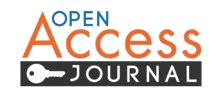General Format
The typing area must be exactly 8.5" wide by 11" long (letter sized page). Justify margins left and right (block format). The entire typing area of each page must be filled, leaving no wasted space. Text should be single-spaced and double-spaced between paragraphs. Special care should be taken to insure that symbols, superscripts and subscripts are legible and do not overlap onto lines above or below. Make sure text lines are equidistant.
?Article Sections
A regular research article may have the following sections.Font: Standard font of Arial, Times Roman, Helvetica, Courier, size 12 point, justified with single line spacing must be used .
Title Page:
The title should be <100 characters (not including spaces). Provide the complete names of the institutions where the work was done, and the name, mailing address, telephone number, fax number, and email address of the corresponding author. If you wish to have two corresponding authors listed for the paper, you must designate one of them to communicate with the editorial office. On the first page of the manuscript, start title 1" (25 mm) down from top text margin. Type title in all capital letters, centered on the width of the typing area and single-spaced if more than one line is required. The title should be brief, descriptive and have all words spelled out. Double-space, then type the author(s) name(s), single-spaced if more than one line is required. Double-space, than type author(s) address(es), also single-spaced, capitalizing first letters of main words. Quadruple-space before Summary.
Running Title:
A brief running title of about 50 characters should be provided.
Key Words:
5 to 8 keywords must be provided.
Abstract:
Abstract must not exceed 200 words, should be self-explanatory and should not contain reference citations. It should concisely summarize the basic content and conclusions of the paper without presenting extensive experimental details. Centre, type and underline summary heading, capitalizing the first letter. A double-space should separate the heading from the summary text. Indent summary text approximately 1/2" (13 mm) from both left and right margins. The summary should be intelligible to the reader without reference to the body of the paper and be suitable for reproduction by abstracting services. Introduction to the text (without a heading) should being four spaces below the summary using full margins. Ideally, the abstract should have following sub-headings,
- Background
- Objective
- Method
- Results
- Conclusion
Major Headings:
Papers must include the major headings: Introduction, Methods, Results, Discussion, Acknowledgments and References. Capitalize first letter, underline, and centre headings on width of typing area.
Introduction:
The Introduction should be concise, with no subheadings, and should present the background information necessary to allow the reader to understand the results presented.
Materials and Methods:
The Materials and Methods section should include sufficient technical information to allow the experiments to be repeated. All companies from which materials were obtained should be listed with their location.
Results:
This section should present clearly but succinctly the experimental findings of the study. Only results essential to establish the main points of the work should be included. In the Results section, include the rationale or design of the experiments as well as the results; reserve extensive interpretation of the results for the Discussion section. Results should be specifically tied to the objectives and methods presented earlier in the manuscript.
Discussion:
The Discussion should provide an interpretation of the results in relation to previously published work and to the experimental system at hand and should not contain extensive repetition of the Results section or reiteration of the introduction. The discussion section should (a) reiterate the principal findings of the research, (b) explain why those findings are important, (c) comment on methodological weaknesses of the study, and (d) provide an overall conclusion. Authors should be careful not to draw conclusions or make inferences that are not specifically supported by the data reported in the study. In short papers, the Results and Discussion sections may be combined
Acknowledgments:
Acknowledgments should be limited to technical, scientific and brief. Authors may briefly mention individuals making significant non-authorship contributions to the manuscript. Funding support for the work presented should be detailed.
Tables/ Figures:
Incorporate tables and/or figures with their legends into the main body of text
Citations:
All citations must be placed in name/date form. Place the citation immediately after the textual information cited, placing name and date within parentheses with a comma.








